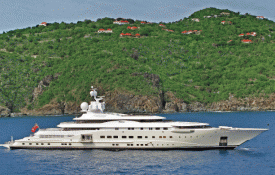Typically, white oak trees grow for 300 years and then die. But the one at fine-furniture maker Frank Pollaro’s Hillside, N.J., workshop is more than 500 years old.
“It was growing in Basking Ridge, New Jersey, and according to their historical society, George Washington had lunch under the tree in May of 1780,” describes Pollaro. “There are also 37 Revolutionary War veterans that were buried under it.”
When it arrived at Pollaro’s workshop and his team was first cutting into it, they discovered a Revolutionary War musket bullet, fired around 1777. The bullet remains intact in the tree, an added detail to an already rare specimen of wood. “We’ll be cutting it and drying the wood for four years,” says Pollaro. “There’s a limited number of pieces we’ll get from it. Fewer than 10 tables, and each will be totally different.”
Wood like this is just the start of what’s in Pollaro’s portfolio. French burled walnut, okoume crotch, amboyna, hundreds of fine Makassar ebony logs, white ebony, chenchen, birds-eye zebrano … the list abounds. “No one in the world has this inventory,” says Pollaro. “When you go to another maker to order an ebony dining table, they’re choosing from whatever is in the supply chain at that moment. There’s no handpicked selection process like what’s available from Pollaro.”

Throughout his 30 years in the business, Pollaro has been making furniture the same way. “I knew when I was 12 that I wanted to make furniture. I never thought about doing anything else. I founded the business when I was 21, with the strategy of building the finest pieces in the world,” he says. “I made no consideration of how much time it took to make something, only how to make the best product with best woods, finishes, and joinery.”
What started as a six-person team in 1988 has grown to a team of 45, who operate at his 60,000-square-foot space that includes his warehouse, offices, and workshop, which includes woodworking, metalworking, and upholstery. His first employee, a high school friend who was an expert in finishing, is still with him today.

The range of pieces that Pollaro creates spans from dining tables, chairs, and cocktail tables—and now rugs, lighting, and teak and titanium furniture for yachts. He recently made a Fibonacci piano for Steinway, to mark its 600,000th piano; it sold for $2.4M. He was also sought out by Alan Faena to create 355 chairs and tables for the hotelier’s Miami Beach property, Pollaro’s largest public installation ever. And Pollaro continues to evolve.
“I have a new partner I’m doing proprietary cashmere-blended rugs with. Most rugs are wool and silk, but these are amazing under your feet, and they are all made by hand in the US,” he says. “We’re also working on five major yachts right now, which are projects that require anywhere from 20 to 100 pieces. I started using titanium and teak for Larry Ellison’s yachts, and it really caught on. Even marine-grade stainless steel eventually rusts, but titanium is completely resistant to rust and salt water.”

Ellison was Pollaro’s first yacht client, an experience that he found game changing. Pollaro had done several pieces for David Geffen, who referred him to his friend, Ellison. “I remember flying out to see the yacht, Rising Sun, which Geffen actually owns now, in Saint Martin. I looked out over the marina and saw a bunch of other yachts, and I saw that we needed to be furnishings those too,” says Pollaro. “From that point on, we changed our marketing and our approach. Yachts like that start at $100M. Those clients also usually have multiple homes.” A typical dining table Pollaro makes from a spectacular wood might start around $100,000, while an average yacht furniture project may cost the client up to $2M.While yachts occupy much of Pollaro’s commissions, he also prides himself in the designer relationships he’s built over the years, frequently working with the likes Victoria Hagan, Susan Orsini, Jamie Drake, and Brian McCarthy.
In spite of the increase in volume and scale of work, Pollaro has never changed his product. “I focus on a few things: rare materials, as I have the largest collection in the world, with a million square feet of veneer and 150 species of woods; I don’t stain or color the wood; and there’s absolutely no CNC equipment automating the process,” he says. “The whole point is that everything is made entirely by hand. Every would-be competitor I have is highly automated, which means that I have no genuine competitor.” pollaro.com












































